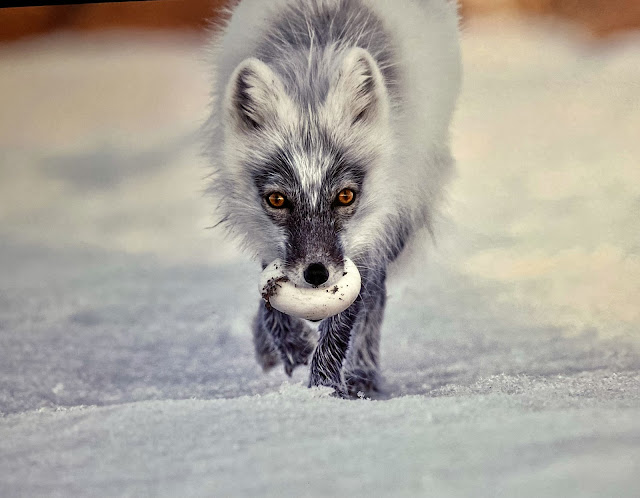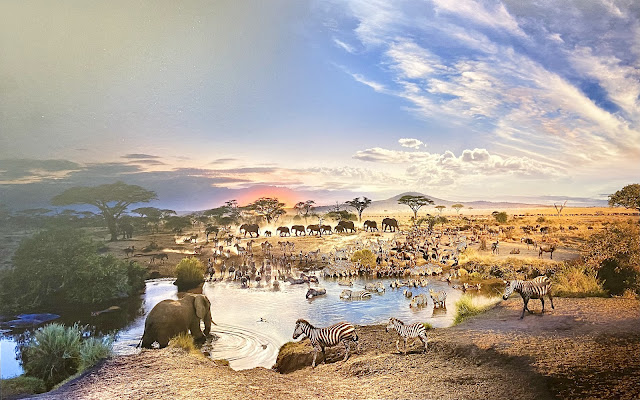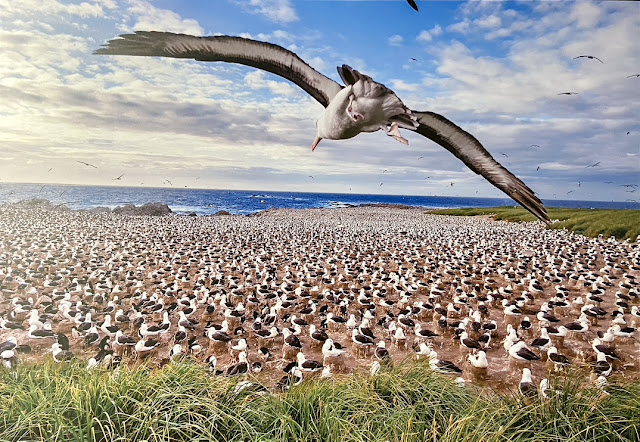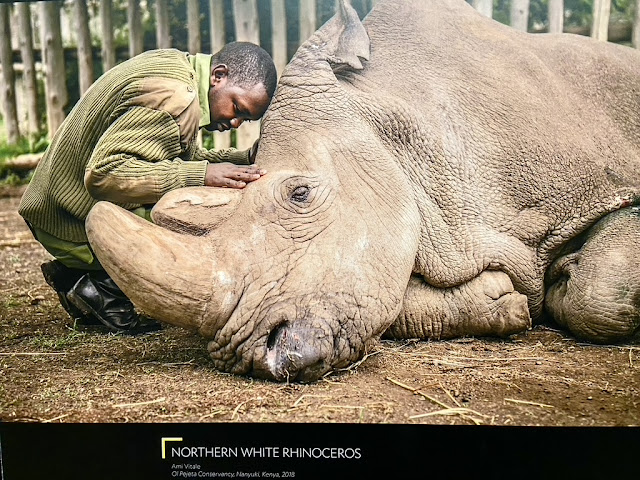"Photography should inspire. Photography should awe. Photography should inform. And at National Geographic, photography should tell a story. Some photos, no matter how wonderful, don't make the pages of National Geographic magazine because they don't advance the narrative. But when an image makes you stop, think, and wonder, that's when the magic happens. And that is the bar every photograph in this exhibition has surpassed." from exhibition information
Currently, our local Arboretum is presenting a new exhibit called The Greatest Wildlife Photos. It shows the best wildlife photos from the pages of National Geographic magazine.
*SERENGETI DAY TO NIGHT, Stephen Wilkes - Serengeti National Park, Tanzania, 2015
On the day of his photo shoot in Tanzania, Stephen Wilkes drove to the watering hole at 1:30 a.m. He was accompanied by an armed park ranger to protect him from wildlife and poachers. He spent the next 26 hours on site photographing the watering hole.
Wilkes considers himself incredibly lucky to have photographed the watering hole on a day when it was visited by so many species, from zebras and wildebeests to elephants and hippos.
He was amazed to see how many rival species shared the watering hole without conflict, relying on a type of communication that humans rarely witness.
*VUMBI PRIDE, Michael Nichols - Serengeti National Park, Tanzania, 2011
Photographer Michael Nichols wanted to capture the unique images of the Vumbi pride. These enormous cats are usually photographed from a vehicle, but Nichols wanted to see them from a different perspective.
He and his team built what they called a “lion tank.” The vehicle was motorized and remote-controlled, and could be driven around the hills and valleys of the lions’ territory. Its cameras were completely encased in metal, making them immune to the lions’ curiosity. Nichols operated the camera from the safety of his vehicle, sending the tank into the pride. When the lions sniffed it, they realized it was harmless and inedible. Nichols managed to position it at eye level with the pride, allowing him to see the world through the lion’s eyes.
He and his team built what they called a “lion tank.” The vehicle was motorized and remote-controlled, and could be driven around the hills and valleys of the lions’ territory. Its cameras were completely encased in metal, making them immune to the lions’ curiosity. Nichols operated the camera from the safety of his vehicle, sending the tank into the pride. When the lions sniffed it, they realized it was harmless and inedible. Nichols managed to position it at eye level with the pride, allowing him to see the world through the lion’s eyes.
*LIONS, Beverly Joubert - Okavango Delta, Botswana, 2007
Some lion prides in the Delta have developed a unique trait. While most cats avoid water, Okavango's lions have adapted to hunting buffalo in the river. Beverly Joubert has spent years documenting these prides, following them on hunts and recording their use of the waterways.
*TIGERS AT A WATER, Steve Winter - Bandhavgarh National Park, India, 2010
Steve Winter has dedicated his career to capturing the beauty of big cats. In Bandhavgarh National Park in India, Winter has set up a watering hole that is a favorite haunt of a tigress and her cubs. Smasher is the male in the background of this photo. Both tigers are believed to have killed humans, and Smasher is now in captivity. Winter hopes his photos of tigers will help preserve them in the wild for future generations.
BIRDS BY THE WATER, Charlie Hamilton James - Gorongosa National Park, Mozambique, 2018
Mozambique’s Gorongosa National Park is recovering from a long civil war that left a scarred landscape and decimated animal populations. But today, the park is a remarkably successful, long-term conservation project that takes into account the parkland, the wildlife, and the well-being of the people living in the surrounding buffer zone. Charlie Hamilton James photo of a water oasis full of birds—including storks, herons, and hammerheads—is a perfect illustration of this conservation success story.
*CASSOWARY, Christian Ziegler - Northeast Queensland, Australia, 2012
Cassowaries are enormous, 150-pound flightless birds that live in the rainforests of Australia and New Guinea. They are five and a half feet tall with beautiful, glossy black feathers; a long, featherless neck; and an unusually high cassowary on top of their head.
Unfortunately, cassowaries are endangered throughout much of their range due to hunting, habitat loss, and predation by feral pigs and dogs. It is estimated that there are fewer than 1,500 southern cassowaries left in the rainforests of Queensland.
Christian Ziegler watched a cassowary named Dad incubate his green eggs and raise his three clumsy, fluffy chicks until they were almost grown and ready to leave him and find their own territory.*HUMMINGBIRD DRINKING NECTAR, Anand Varma - California, U.S.A.. 2016
These birds can flick their forked tongues up to 15 times a second, so capturing this precise shot meant choosing the right equipment. Anand Varma works in a lab-like studio, using cameras with shutter speeds as fast as 1/13,500 of a second. Next, Varma had a glassblowing company craft a custom, handmade glass plate just for the shoot. He carefully angled the vessel so it would appear to float mid-photo. He then trained the tiny bird to feed through the pinhole opening on the side of the delicate glass container.
*BIRD OF PARADISE, Tim Laman - Wokam Island. New Guinea, Indonesia, 2010
None of New Guinea's wonders have fascinated scientists as deeply as the creatures that 19th-century naturalist Alfred Russel Wallace called
the most extraordinary and the most beautiful of the feathered inhabitants of the Earth - the birds of paradise.
In 2003, Cornell ornithologist Edwin Scholes and biologist and photographer Tim Laman started the Bird of Paradise Project to document every species of the birds of paradise. It took them eight years and 18 expeditions to some of the planet's most exotic landscapes.
Tim Laman took this picture with the help of the natives people. Several of them entered the canopy with Laman and wove a beautiful curtain from tree leaves. He managed to take this picture the very next day.
*WHITE-BELLIED PANGOLINS, Joel Sartore - St. Augustine, Florida, U.S.A., 2015
National Geographic photographer Joel Sartore is the creator of the Photo Ark project, which aims to take studio-style portraits of each of the estimated 20,000 species in zoos and sanctuaries around the world.
*AMERICAN FLAMINGO, Jasper Doest - Willemstad, Curaçao, 2018
Odette Doest, a veterinarian on the Caribbean island of Curaçao, rescued this American flamingo in 2016 after it flew into a hotel window. Odette took the concussed bird into her care and nursed it back to health. She also diagnosed the bird with a chronic foot condition that would have made foraging in the wild impossible, so Odette keeps the flamingo at her animal sanctuary.
After visiting schools and gaining media attention, the bird became a local celebrity, and Odette gave it a name that reflects its relaxed charisma: Flamingo Bob.
Odette's cousin Jasper, a conservation photographer who took this picture of Bob paddling in the Caribbean, first met the celebrity bird when it sauntered into his bedroom at Odette's house. "He walks around like he's king," Jasper says of Bob, who enjoys dining on caviar, wading in his own saltwater pool, and receiving regular beachside foot massages. "We see a lot of gloom-and-doom stories. This was a great chance to show a positive side."
*POLAR BEAR, Paul Nicklen - Nunavut, Canada, 2004
"I had been dreaming of getting pictures of polar bears underwater for 10 years," says photographer Paul Nicklen. "But I didn't want to be pushing the bears into an uncomfortable position, so it never happened. Then one day I was out photographing narwhals, saw a large male bear, and realized this might be my chance. I got my 12-foot aluminum boat up beside the bear in the water. And I just photographed it blind.
I put my underwater camera into the water and got the shot... It turned out to have a nice reflection, nice light.
"I had been dreaming of getting pictures of polar bears underwater for 10 years," says photographer Paul Nicklen. "But I didn't want to be pushing the bears into an uncomfortable position, so it never happened. Then one day I was out photographing narwhals, saw a large male bear, and realized this might be my chance. I got my 12-foot aluminum boat up beside the bear in the water. And I just photographed it blind.
I put my underwater camera into the water and got the shot... It turned out to have a nice reflection, nice light.
*POLAR BEARS, Katie Orlinsky - Kaktovik, Alaska, U.S.A. 2015
Katie Orlinsky photographed these bears just outside the Inupiat village of Kaktovik, Alaska.
The village is located near the Arctie National Wildlife Refuge, and polar bears are a common sight in and around the settlement. They’re drawn to the large piles of whale bones and blubber that the Inupiat gather after the annual whale hunt. This happens during the bears’ fasting period, and it gives the bears a much-needed source of food.
The bears have been affected by climate change. Sea ice has been melting for decades, leaving fewer and fewer places for seals to emerge from their breathing holes, where the bears wait patiently to “hunt in silence” while trying to satisfy their intense calorie needs. As a result, bears must walk and swim greater distances to find suitable ice – risking starvation.
*HARP SEAL PUP, Jennifer Hayes - Gulf of St. Lawrence, Canada, 2012
Jennifer Hayes captured this photo of a harp seal pup peering at its mother through the frigid water in Canada's Gulf of St. Lawrence. Hayes was on assignment for National Geographic magazine, photographing the two-week process of harp seal mother-pup bonding, during which a mother seal gives birth on the ice, nurses her pup for roughly two weeks, then leaves the pup to fend for itself.
Jennifer Hayes captured this photo of a harp seal pup peering at its mother through the frigid water in Canada's Gulf of St. Lawrence. Hayes was on assignment for National Geographic magazine, photographing the two-week process of harp seal mother-pup bonding, during which a mother seal gives birth on the ice, nurses her pup for roughly two weeks, then leaves the pup to fend for itself.
While photographing one harp seal pup swimming after its mother, the pup settled on Hayes chest and nuzzled her. The tranquility of the moment quickly gave way to danger, however, as a group of male harp seals began circling below. One bit at her ankle to test her; another pushed her underwater and pulled her mask off. The mother aggressively intervened, using her body to push both her pup and Hayes away from the males. Though Hayes describes herself as a skeptic, the encounter left her certain that the mother was nudging them both to safety. "I can't explain why it happened, she says. "I can only embrace what happened and share it."
*SEA PENS AND BLUE COD, Brian Skerry - Fiordland, New Zealand, 2006
In Fiordland, New Zealand, a unique marine ecosystem exists in which tannin-stained freshwater flows in rivers from the mountains to the sea. The dark water sits on top of saltwater, blocking the sunlight from reaching the depths below. Colorful creatures such as blue cod and sea pens, a type of coral that typically lives in deep water, are sometimes tricked into believing they are in deep water due to the darkness.
Photographer Brian Skerry was not deep when he took this image-although it looks like he's in the deepest trenches of the ocean. When he jumped off the boat, he found himself in what seemed like dirty water, barely able to see. But after descending 25 feet, the seascape exploded into color.
*SPINNER DOLPHINS, Brian Skerry - Oah'u, Hawaii, U.S.A., 2013
Photographer Brian Skerry, assigned to take photos for an article on dolphin cognition, spent weeks learning about the animal.
One of the species Brian Skerry was interested in was the spinner dolphin (Stenella longirostris). But the challenge was that spinner dolphins are primarily nocturnal.
During the day, the dolphins enter shallower waters to rest.
Through his research and experience, and with the guidance of biologists he worked with, Skerry managed to blend in enough that the dolphins continued their natural behaviors—and he managed to get the shot.
*BLACKTIP REEF SHARKS, Thomas P. Peschak - Aldabra Atoll, Seychelles Islands, 2014
The Aldabra Atoll is a group of four small islands in the Indian Ocean, part of the Seychelles archipelago. At low tide, the sharks gather in a small lagoon on the reef, where the strong currents wash them over with cooler water. They avoid the deeper water at the edge of the reef, where larger sharks can hunt them.
At low tide, Peschak waded out into the water, plunked a stepladder down in the midst of a nursery of blacktop reef sharks, and got the picture.
*BEETLE SAMURAI, Mark W. Moffett/Minden Pictures - French Guiana, 1998
Of the 1.75 million species identified by science, insects make up about 60 percent, and a third of those are in the order Coleoptera- beetles. Longhorn beetles (Macrodontia cervicornis) like this one can exceed four inches in length.
Listed as endangered by the International Union for Conservation of Nature (IUCN), they have a long larval period, making them very vulnerable to the effects of deforestation.
It’s unclear exactly what the world looks like through the compound eyes of a beetle, but photographer Mark Moffett offers a different perspective on these animals/creatures that most might find unattractive
*HONEYBEE, Anand Varma - California, U.S.A., 2015
The photo was taken for a National Geographic article about the many threats to honeybees. To capture a young honeybee emerging from a brood cell, Anand Varma used backlighting to bring out the amber color of the hive. “When I saw that deep red glow, it made sense,” Varma says. The bee world is on fire.
*ELEPHANT SEALS, Paul Nicklen - St. Andrews Bay, South Georgia Island, 2008
The first sealing ships arrived on South Georgia Island, in the remote southern Atlantic Ocean, in the late 1700s. Over the following centuries, these Antarctic seals were hunted to the brink of extinction, and southern elephant seals were killed in large numbers.
Today, South Georgia Island is a haven for them, and during breeding season, it is home to the densest mass of marine mammals on Earth.
Beaches become battlegrounds as large bulls engage in bloody duels for dominance.
*NORTHERN WHITE RHINOCEROS, Ami Vitale - Ol Pejeta Conservancy, Nanyuki, Kenya, 2018
Photographer Ami Vitale first met Sudan, the last remaining male northern white rhino, in 2009. He and three other members of his subspecies were about to be moved from their brick-and-iron enclosures at a zoo in the Czech Republic to the open, airy Ol Pejeta Conservancy in central Kenya.
Sadly. The last-ditch attempt to save these rhinos was unsuccessful. When Sudan died of old age on March 19, 2018, hopes for saving northern white rhinos were extinguished. "The species...had survived for millions of years," Vitale said, "but could not survive mankind."
Vitale's photograph of ranger Joseph Wachira saying goodbye to Sudan just moments before his death made the cover of the October 2019 issue of National Geographic.
*ORANGUTAN, Tim Laman - Gunung Palung National Park, Borneo, Indonesia, 2015
Capturing a subject in its true habitat is a challenge, especially when the subject is an orangutan—an animal that is skittish, unaccustomed to the sight of humans, and whose home is 100 feet above the treetops. Photographer Tim Laman spotted an orangutan climbing the roots of this fig tree.
*GELADAS, Trevor Frost - Menz-Guassa Community Conservation Area, Ethiopia, 2015
Geladas, one of the flagship species of Africa’s alpine grasslands, are found only in the Ethiopian Highlands. At the Menz-Guassa Community Conservation Area, scientists from Ethiopia and abroad are tracking the details of the daily lives of nearly 500 geladas. They monitor the primates’ activities, study their relationships, track births and document deaths. But much about the geladas remains unknown. It’s still unclear how many geladas remain.
*WESTERN LOWLAND GORILLA, Michael Nichols - Odzala-Kokoua National Park, Republic of the Congo, 2000
Photographer Michael "Nick" Nichols documented wildlife in a clearing in the Republic of the Congo's Odzala-Kokoua National Park. For six weeks, Nichols woke at 430 a.m., made coffee and instant oatmeal, and trekked through the jungle to the clearing, where he spent the next 10 hours making images of whatever came by. Then he trekked back, cooked a freeze-dried dinner, and did it all again the next day.
One day a western lowland gorilla family group came into the clearing to feed, play, and groom. Completely unfazed by Nichols, they went about their business. The photographer watched as a silverback male struck a display pose, surrounded by butterflies.
I used the information presented at the exhibition





























